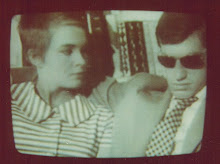Johanna Demetrakas' feature-length documentary film tells a long detailed story of Chogyam Trungpa, the 11th descendant of Trungpa tulkus. Often referred to as the "bad boy of buddhism," he came of age during the last generation of Tibetan monks to be assigned highly-regarded Kagyu lamas. Khenpo Ghanshar Wangpo was Trungpa's primary teacher for about five years until the monks were told to flee Tibet when the Chinese invaded during the late 1950s.
Trungpa set out with other monks for India, a journey that took 6 months. This challenge became the metaphor for his message to students going forward. "Do not be afraid. Do not be a coward." He studied at Oxford during the early 1960s to learn about how people in the west suffer and develope his approach to teaching the Dharma (teachings used to open a student's mind to reality of things as they are).
Trungpa Rinpoche and one of the monks he traveled from Tibet with, Akon Rinpoche, formed a teaching center in Scotland called Samye Ling. A pivotal moment for Trungpa was a journey to Bhutan, where he retreated in the location where Padmasambhava meditated in 800BC. There he wrote the Sadhana Mahamudra in 5 hours. This text describes a dark age when spirital values have been lost. "The river of materialism has burst its banks."
Although, Akong and Trungpa had a large following of students at Samye Ling, Akong wanted to develop the center as a place for Tibetan refugees. Trungpa had a different vision. He removed his robes and went to London to live as an ordinary man. He met a young girl named Diana. He was also involved in an accident when the car he was driving crashed through a jokeshop window. His throat was slashed and he became paralyzed on the left side.
His struggle escalated as he recovered from the accident. He became increasingly troubled by the notion of the golden buddha on the pedestal and monks in robes. "People do not see a person--they see only the robe and their pet guru." He wore a mirror on a chain around his neck as a way to professize. Many rejected him for his unconventional ways--others adored him.
The film footage includes interviews with Trungpa's wife, Diana Mukpo. She tells about this time when he told her that he was on the verge of something...either he was going crazy or becoming enlightened. In 1968 they immigrated to North America so that that he could begin offering his teachings to Americans.
He established Karme Choling in Vermont before relocating to Colorado, where another group of students assembled. A large land center was established in the mountains of Red Feather Lakes, just northwest of Boulder. In 1974 he orchestrated the first buddhist-inspired university. Naropa Institute was a gathering place from pure vision. Spiritual leaders of all kinds were invited to converge and allow sparks to fly...Gregory Bateson, Allen Ginsberg, Ram Dass, Anne Waldren...and so many others.
The film includes footage and interviews with many who contributed to those early programs. Ram Dass spoke about the days when they worked closely together. He was the heart. Trungpa was the head. "You can survive by doing nothing."
During this time when hippie culture prevailed, Trungpa met the students exactly where they were and gradually introduced new ways of being. Many left the fold when he began asking more of them. Some could not accept the idea of dressing up--wearing a suit and tie.
He was relentless in his emphasis on dismantling the ways we cling to ego. The message over and over was about the elimination of self-deception. He knew he had to enter American mindset through language. "In order to meet majesty within, one must meet majesty outside."
His Kagyu Budhhist teachings later emphasized the Shambhala teachings, a non-secular approach to meditation practice that now includes over 200 centers worldwide.
He coined the phrase, "taming the mind" and taught how to attain equilibrium. Famous for unmasking people, some feared him for that, but he kept on presenting the idea that there is no certainty and you can have a sense of humor about that. He made everything personal and emphasized that the path is under us when we continually open to what is being encountered. The Bodhissattva way makes being a benefit to others our guiding principle in life.
He introduced the notion of Dharma Art. Instead of paint a river--be a river. Receive images without struggle--allow natural dignity to emerge. He called his group of Dharma Art helpers Explorers of the Richness of the Phenomenal World. This is a practice in appreciation of the world of senses. His frequent public drunkenness is well known, but some claim that his apparent awareness of his enviroment seemed unaffected by the intoxication.
He spoke at the funeral of his good friend, Suzuki Roshi. When he stood there and cried, the entire community were given permission to grieve more fully.
The film is full of interviews with several of his students who later became teachers, including Pema Chodron. Trungpa's son, Mipham, now Sakyong Mipham Rinpoche, continues the lineage as spiritual director of Shambhala International.
3000 gathered for his cremation at Karme Choling after his early death in 1987 at age 47. A rainbow formed in the sky as the funeral pyre was burning.
The film is a moving look at an important teacher of the 20th century whose legacy and influence continue to thrive.
7/19/11
Subscribe to:
Post Comments (Atom)





No comments:
Post a Comment